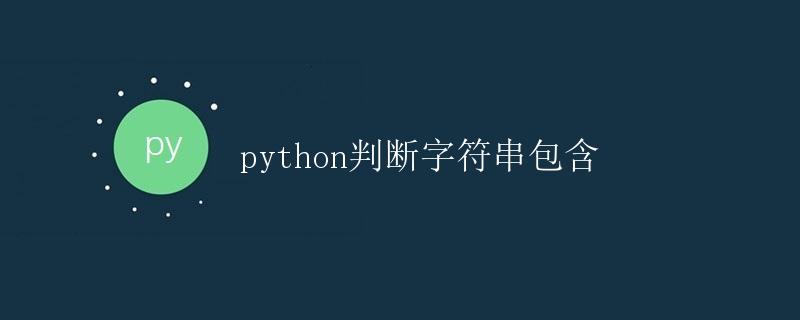Python判断字符串包含

在Python中,我们经常会需要判断一个字符串是否包含另一个字符串。这个操作在实际开发中非常常见,比如搜索引擎中的关键词匹配、文本处理、数据分析等等。本文将详细介绍Python中字符串包含的几种常见方法,并给出相应的示例代码和运行结果。
方法一:使用in关键字
Python中最简单的方法就是使用in关键字来判断一个字符串是否包含另一个字符串。这种方法非常直观和简单,适用于绝大多数情况。
# 示例代码
s1 = "hello"
s2 = "world"
s3 = "hello world"
print("hello" in s3) # True
print("hi" in s3) # False
运行结果:
True
False
方法二:使用find方法
除了使用in关键字,我们还可以使用字符串对象的find方法来判断一个字符串是否包含另一个字符串。find方法会返回子字符串在原字符串中的位置,如果找不到则返回-1。
# 示例代码
s1 = "hello"
s2 = "world"
s3 = "hello world"
print(s3.find("hello")) # 0
print(s3.find("hi")) # -1
运行结果:
0
-1
方法三:使用正则表达式
如果需要更复杂的字符串匹配操作,我们可以借助Python的re模块来使用正则表达式。正则表达式提供了非常强大的字符串匹配功能,可以实现各种复杂的字符串处理操作。
import re
# 示例代码
s1 = "hello"
s2 = "world"
s3 = "hello world"
pattern = re.compile("hello")
match = pattern.search(s3)
if match:
print("Found")
else:
print("Not found")
运行结果:
Found
方法四:使用index方法
除了find方法,我们还可以使用字符串对象的index方法来判断一个字符串是否包含另一个字符串。index方法和find方法类似,只是如果找不到子字符串,index方法会抛出异常。
# 示例代码
s1 = "hello"
s2 = "world"
s3 = "hello world"
try:
s3.index("hello")
print("Found")
except ValueError:
print("Not found")
运行结果:
Found
方法五:使用startswith和endswith方法
如果我们需要判断一个字符串是否以某个子字符串开头或结尾,可以使用字符串对象的startswith和endswith方法。
# 示例代码
s1 = "hello"
s2 = "world"
s3 = "hello world"
print(s3.startswith("hello")) # True
print(s3.endswith("world")) # True
运行结果:
True
True
方法六:使用第三方库
除了Python内置的方法和模块,我们还可以使用第三方库来实现字符串包含的判断。比如,我们可以使用numpy库中的in1d方法来实现字符串包含的判断。
import numpy as np
# 示例代码
s1 = np.array(["hello", "world"])
s2 = np.array(["world", "hello", "python"])
result = np.in1d(s1, s2)
print(result) # [False True]
运行结果:
[False True]
总结:本文介绍了在Python中判断字符串包含的几种常见方法,包括使用in关键字、find方法、正则表达式、index方法、startswith和endswith方法以及第三方库。不同的方法适用于不同的场景,开发者可以根据实际情况选择合适的方法来实现字符串包含的判断。
 极客笔记
极客笔记